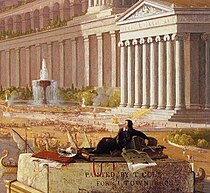
Greek Revival architecture was a style that began in the middle of the 18th century but which particularly flourished in the late 18th and early 19th centuries, predominantly in northern Europe, the United States, and Canada, as well as in Greece itself following its independence in 1832. It revived many aspects of the forms and styles of ancient Greek architecture, in particular the Greek temple. A product of Hellenism, Greek Revival architecture is looked upon as the last phase in the development of Neoclassical architecture, which was drawn from Roman architecture. The term was first used by Charles Robert Cockerell in a lecture he gave as an architecture professor at the Royal Academy of Arts in London in 1842.

Neoclassicism was a Western cultural movement in the decorative and visual arts, literature, theatre, music, and architecture that drew inspiration from the art and culture of classical antiquity. Neoclassicism was born in Rome largely thanks to the writings of Johann Joachim Winckelmann, at the time of the rediscovery of Pompeii and Herculaneum, but its popularity spread across Europe as a generation of European art students finished their Grand Tour and returned from Italy to their home countries with newly rediscovered Greco-Roman ideals. The main Neoclassical movement coincided with the 18th-century Age of Enlightenment, and continued into the early 19th century, latterly competing with Romanticism. In architecture, the style continued throughout the 19th, 20th and up to the 21st century.

The art of Europe, also known as Western art, encompasses the history of visual art in Europe. European prehistoric art started as mobile Upper Paleolithic rock and cave painting and petroglyph art and was characteristic of the period between the Paleolithic and the Iron Age. Written histories of European art often begin with the Aegean civilizations, dating from the 3rd millennium BC. However a consistent pattern of artistic development within Europe becomes clear only with Ancient Greek art, which was adopted and transformed by Rome and carried; with the Roman Empire, across much of Europe, North Africa and Western Asia.

Ithiel Town was an American architect and civil engineer. One of the first generation of professional architects in the United States, Town made significant contributions to American architecture in the first half of the 19th century. His work, in the Federal and revivalist Greek and Gothic revival architectural styles, was influential and widely copied.

Néo-Grec was a Neoclassical Revival style of the mid-to-late 19th century that was popularized in architecture, the decorative arts, and in painting during France's Second Empire, or the reign of Napoleon III (1852–1870). The Néo-Grec vogue took as its starting point the earlier expressions of the Neoclassical style inspired by 18th-century excavations at Pompeii, which resumed in earnest in 1848, and similar excavations at Herculaneum. The style mixed elements of the Graeco-Roman, Pompeian, Adam and Egyptian Revival styles into "a richly eclectic polychrome mélange." "The style enjoyed a vogue in the United States, and had a short-lived impact on interior design in England and elsewhere."

Thomas Cole was an English-born American artist and the founder of the Hudson River School art movement. Cole is widely regarded as the first significant American landscape painter. He was known for his romantic landscape and history paintings. Influenced by European painters, but with a strong American sensibility, he was prolific throughout his career and worked primarily with oil on canvas. His paintings are typically allegoric and often depict small figures or structures set against moody and evocative natural landscapes. They are usually escapist, framing the New World as a natural eden contrasting with the smog-filled cityscapes of Industrial Revolution-era Britain, in which he grew up. His works, often seen as conservative, criticize the contemporary trends of industrialism, urbanism, and westward expansion.

"Ode on a Grecian Urn" is a poem written by the English Romantic poet John Keats in May 1819, first published anonymously in Annals of the Fine Arts for 1819.
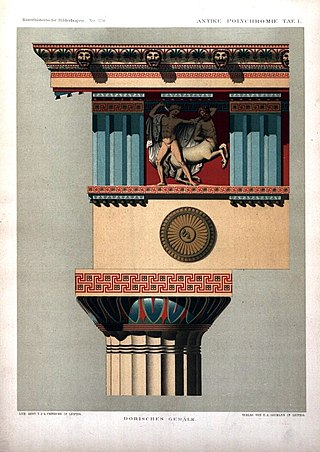
Polychrome is the "practice of decorating architectural elements, sculpture, etc., in a variety of colors." The term is used to refer to certain styles of architecture, pottery, or sculpture in multiple colors.

American Gothic is a 1930 painting by Grant Wood in the collection of the Art Institute of Chicago. A character study of a man and a woman portrayed in front of a home, American Gothic is one of the most famous American paintings of the 20th century, and has been widely parodied in American popular culture.
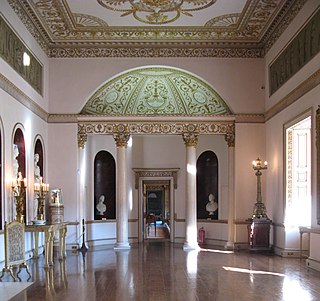
The Adam style is an 18th-century neoclassical style of interior design and architecture, as practised by Scottish architect William Adam and his sons, of whom Robert (1728–1792) and James (1732–1794) were the most widely known.

The culture of Europe is diverse, and rooted in its art, architecture, traditions, cuisines, music, folklore, embroidery, film, literature, economics, philosophy and religious customs.
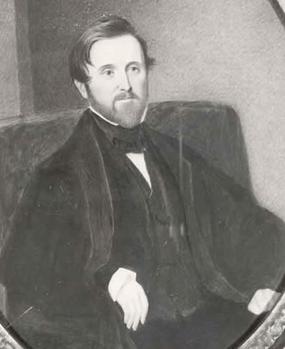
Alexander Jackson Davis was an American architect known particularly for his association with the Gothic Revival style.
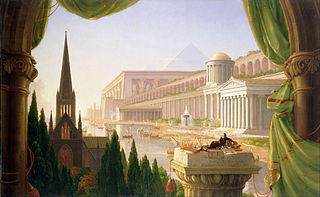
The history of architecture traces the changes in architecture through various traditions, regions, overarching stylistic trends, and dates. The beginnings of all these traditions is thought to be humans satisfying the very basic need of shelter and protection. The term "architecture" generally refers to buildings, but in its essence is much broader, including fields we now consider specialized forms of practice, such as urbanism, civil engineering, naval, military, and landscape architecture.

Spanish Renaissance architecture was that style of Renaissance architecture in the last decades of the 15th century. Renaissance evolved firstly in Florence and then Rome and other parts of the Italian Peninsula as the result of Renaissance humanism and a revived interest in Classical architecture. In Spain, the Renaissance began to be grafted to Gothic forms as mathematicians and engineers rediscovered building as one of the technological sciences. In the time of King Felipe II (1556–1589), the Renaissance influence expanded throughout the territory thanks to the dissemination of architectural treatises.
James Harrison Dakin was an American architect who designed Neo-Gothic buildings and was the architect for the Old Louisiana State Capitol, Old Bank of Louisville, and other public buildings.

In architecture and the decorative arts, a mascaron ornament is a face, usually human, sometimes frightening or chimeric, whose alleged function was originally to frighten away evil spirits so that they would not enter the building. The concept was subsequently adapted to become a purely decorative element. The most recent architectural styles to extensively employ mascarons were Beaux Arts and Art Nouveau. In addition to architecture, mascarons are used in the other applied arts.

Architectural revivalism is the use of elements that echo the style of a previous architectural era that have or had fallen into disuse or abeyance between their heyday and period of revival. Revivalism, in a narrower sense, refers to the period of- and movement within- Western architectural history during which a succession of antecedent and remenescent styles were taken to by architects, roughly from the late 18th century, and which was itself succeeded by Modernism. Notable revival styles include Neoclassical architecture, and Gothic Revival. Revivalism is related to historicism.

Islamic influences on Western art refers to the stylistic and formal influence of Islamic art, defined as the artistic production of the territories ruled by Muslims from the 7th century onward, on European Christian art. Western European Christians interacted with Muslims in Europe, Africa, and the Middle East and formed a relationship based on shared ideas and artistic methods. Islamic art includes a wide variety of media including calligraphy, illustrated manuscripts, textiles, ceramics, metalwork, and glass, and because the Islamic world encompassed people of diverse religious backgrounds, artists and craftsmen were not always Muslim, and came from a wide variety of different backgrounds. Glass production, for example, remained a Jewish speciality throughout the period. Christian art in Islamic lands, such as that produced in Coptic Egypt or by Armenian communities in Iran, continued to develop under Islamic rulers.

The Titan's Goblet is an oil painting by the English-born American landscape artist Thomas Cole. Painted in 1833, it is perhaps the most enigmatic of Cole's allegorical or imaginary landscape scenes. It is a work that "defies full explanation", according to the Metropolitan Museum of Art. The Titan's Goblet has been called a "picture within a picture" and a "landscape within a landscape": the goblet stands on conventional terrain, but its inhabitants live along its rim in a world all their own. Vegetation covers the entire brim, broken only by two tiny buildings, a Greek temple and an Italian palace. The vast waters are dotted with sailing vessels. Where the water spills upon the ground below, grass and a more rudimentary civilization spring up.
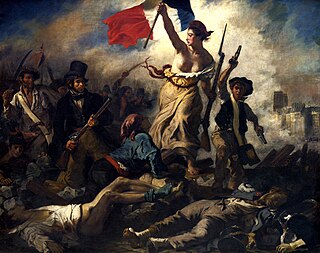
Romanticism was a literary and artistic movement that appeared in France in the late 18th century, largely in reaction against the formality and strict rules of the official style of neo-classicism. It reached its peak in the first part of the 19th century, in the writing of François-René de Chateaubriand and Victor Hugo, the poetry of Alfred de Vigny; the painting of Eugène Delacroix; the music of Hector Berlioz; and later in the architecture of Charles Garnier. It was gradually replaced beginning in the late 19th century by the movements of Art Nouveau, realism and modernism.

